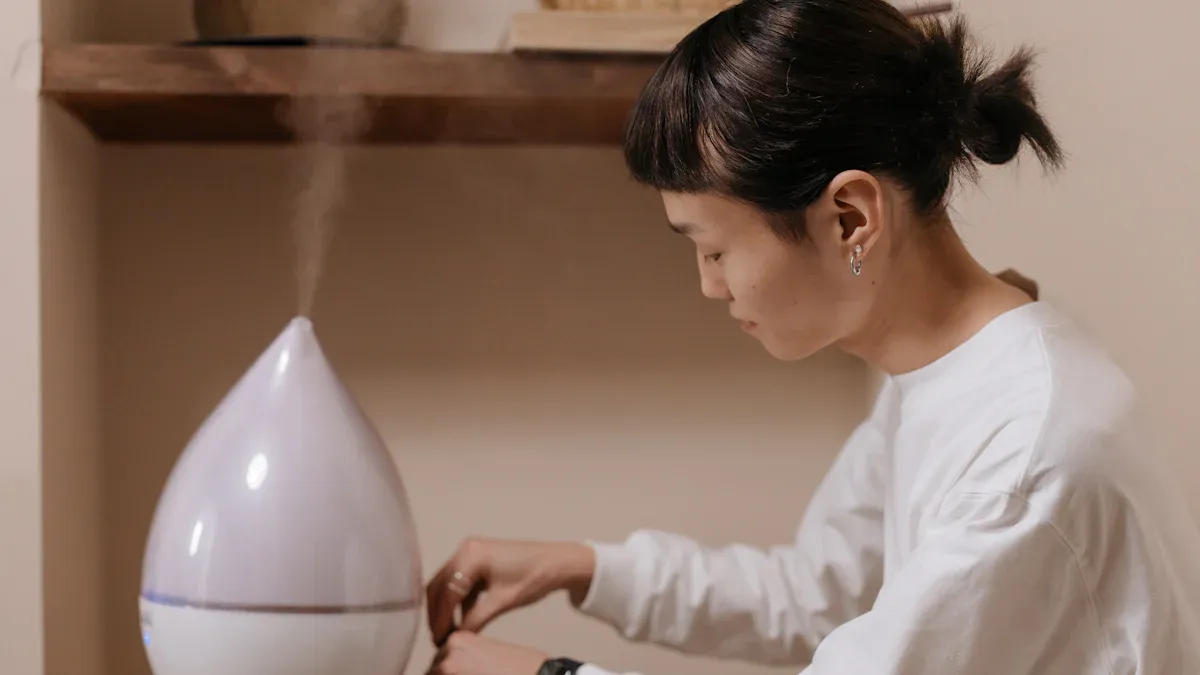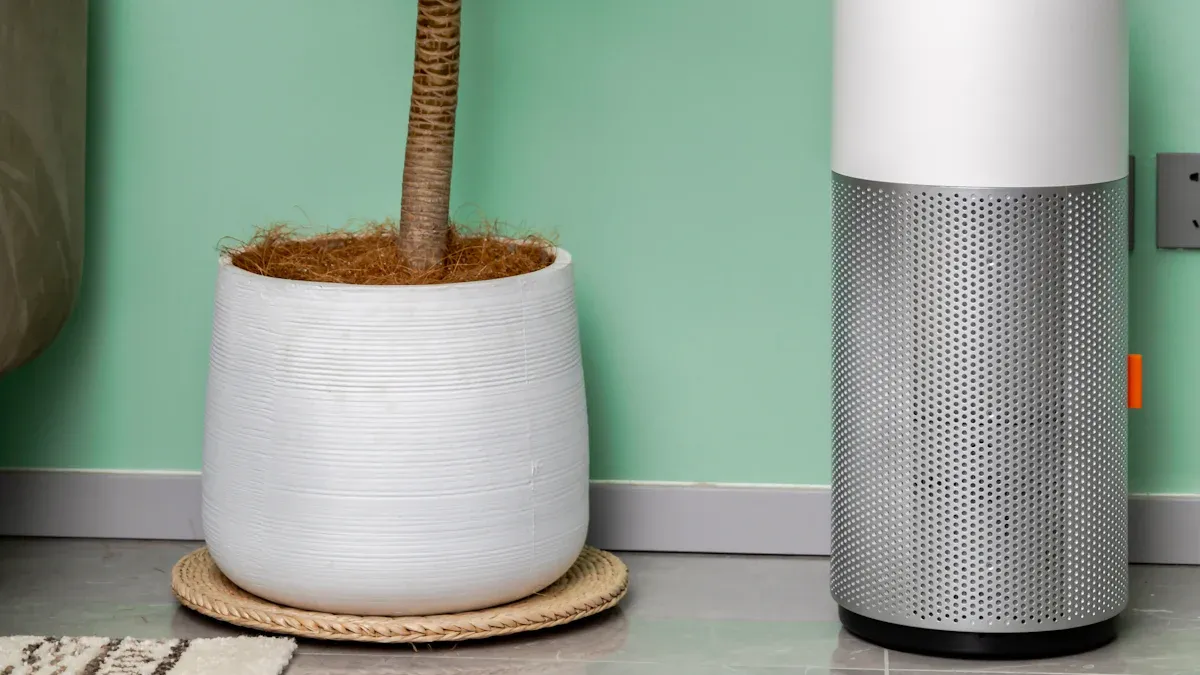
A humidifier does not make your air cleaner. It just puts more moisture in the air. This can help with dry skin and sore noses. Health experts say humidifiers do not take out dust or pollen. They also do not remove other things that make air dirty. Air purifiers are different because they trap bad particles. A humidifier only lets out water vapor. If you use it too much or forget to clean it, mold and bacteria can grow. Knowing this helps you keep your home safe and comfy.
Key Takeaways
- Humidifiers put water into dry air but do not clean air or take out dust, pollen, or germs. Air purifiers catch dust, allergens, and bad particles to make air better. Use distilled water and clean your humidifier often to stop mold, germs, and white dust. Keep humidity from 30% to 50% to feel good and stop mold from growing. Use humidifiers for dry air and air purifiers for allergies or dirty air, and keep them apart so they work well.
How Humidifiers Work

A humidifier puts water vapor into the air at home. People use it to help with dry skin or sore throats. It also helps when your nose feels stuffy. The main job of a humidifier is to add moisture. It does not take out dust or pollen. It also does not remove other particles. Breathing moist air helps your nose and throat feel better. This is helpful in winter or when the air is dry.
Types of Humidifiers
There are different types of humidifiers you can pick. Each one works in its own way and changes your air differently.
- Ultrasonic humidifiers make a cool mist with sound waves. They are quiet and do not use much power. If you use tap water, they can put small minerals in the air. These minerals can turn into white dust on your things.
- Evaporative humidifiers have a fan that blows air through a wet filter. This kind does not put out many minerals or dust. It is good if you want to stop white dust.
- Impeller humidifiers use a spinning disk to spray water. They are safe and do not cost much. They can be loud and are used in big rooms or work places.
- Warm mist humidifiers boil water to make steam. The steam kills most germs and mold. This type gives cleaner mist but uses more power and gets hot.
Tip: If you have kids or pets, a cool mist humidifier is safer. It does not get hot.
Here is a table to help you see the main types:
| Type | How It Works | Particle Emission | Safety Notes |
|---|---|---|---|
| Ultrasonic | Vibrates water into mist | High (white dust) | Cool mist, quiet |
| Evaporative | Fan blows air through wet filter | Low | Needs filter changes |
| Impeller | Spinning disk throws water droplets | Medium | Noisy, less common |
| Warm Mist | Boils water for steam | Very low | Hot, risk of burns |
What Humidifiers Add
A humidifier adds water vapor to the air you breathe. This stops your skin, nose, and throat from getting too dry. If you use tap water, some humidifiers, like ultrasonic ones, can add minerals like calcium and magnesium to the air. These minerals can turn into white dust on your furniture. Using distilled water can help stop this from happening. Some humidifiers can also spread germs if you do not clean them. Always keep your humidifier clean to stay safe.
Humidifier Limitations
No Air Purification
Some people think a humidifier can clean air, but it cannot. It only puts more moisture in your room. It does not take out chemicals, mold spores, pet dander, or other floating particles. The Oransi blog says humidifiers do not purify air or remove airborne contaminants. Even if you have allergies or asthma, a humidifier will not take away things that cause your symptoms. You should not count on a humidifier to make air cleaner or safer.
Note: Dehumidifiers do not clean the air either. They just lower moisture and do not remove mold spores or other particles.
Potential Risks
A humidifier can cause problems if you do not use it right. Some types, like ultrasonic and impeller humidifiers, can spread minerals and germs from the water tank into the air. This can make people sick, especially those with asthma or allergies. Studies from the government and scientists show these humidifiers can release microorganisms and minerals. This may cause breathing problems, allergic reactions, or even lung inflammation. If you use tap water, you might see white dust on your furniture. This dust comes from minerals in the water.
Here are some risks you should know about:
- Dirty humidifiers can spread mold spores, bacteria, and mineral dust into the air.
- You might get breathing problems, allergic reactions, or asthma flare-ups from a dirty humidifier.
- “Humidifier fever” is a flu-like sickness that can happen if you breathe in germs from a humidifier.
- Fungal aerosols from cold-mist humidifiers can cause allergic and breathing symptoms.
- Microorganisms grow fast in standing water, so you need to empty and dry the tank every day and clean it every three days.
If you do not take care of your humidifier, it can also spread Legionella bacteria. This bacteria causes a serious lung infection called Legionnaires’ disease. Sometimes, using chemical disinfectants in humidifiers has caused bad lung injuries, like in a big outbreak in Korea. This shows that both germs and chemicals in humidifiers can hurt your health.
Tip: Always use distilled water and clean your humidifier often. This helps lower the risk of spreading germs and minerals into your air.
Air Purifiers vs Humidifiers

Air Purifiers
Air purifiers help take out bad stuff from the air. They use filters like HEPA to catch dust, pollen, pet dander, mold spores, and some germs. Many air purifiers have activated carbon to cut down on smells and some gases. Hospitals use air purifiers to lower the chance of getting sick by removing germs and harmful things. You can buy air purifiers that follow strict rules for safety and how well they work. They do their job best if you change the filters on time and keep them clean.
- HEPA filters catch 99.97% of tiny particles, even ones as small as 0.3 microns.
- Air purifiers help lower allergens, dust, and germs in the air.
- Some air purifiers use UV light or ionizers for extra cleaning.
- Cleaning and changing filters keeps air purifiers working well.
Tip: Air purifiers do not put water in the air. They only clean the air.
Key Differences
You may wonder how air purifiers and humidifiers are different. The biggest difference is what they do and how they work. Air purifiers clean the air by taking out particles. Humidifiers add moisture but do not take out dirty stuff.
| Feature | Air Purifier | Humidifier |
|---|---|---|
| Main Function | Removes dust, pollen, mold, bacteria, viruses, and odors | Adds moisture to dry air |
| Technology | Uses filters (HEPA, carbon), fans, UV, or ionizers | Uses steam, ultrasonic, or evaporative methods |
| Health Benefit | Reduces allergens and improves air quality | Relieves dry skin and throat |
| Limitation | Does not add moisture | Does not remove particles |
If you use both, keep them apart in your home. Too much water near an air purifier can make the filter wet. This can let mold or germs grow inside the purifier.
When to Use Each
Use an air purifier if you want to get rid of allergens, dust, smoke, or germs at home. This helps if you have asthma, allergies, or live where there is a lot of pollution. Air purifiers work all year, but they are extra helpful during allergy season or when the air outside is bad.
A humidifier is good when the air feels dry. Dry air can make your skin, throat, and nose feel sore. You might need a humidifier in winter or if your heater dries out the air. Keep the humidity in your home between 30% and 50% to stop mold and dust mites.
Note: You can use both for comfort and clean air. Put them in different places and clean them often to avoid problems.
Humidifier Best Practices
Cleaning and Maintenance
Cleaning your humidifier often helps keep your air healthy. If you do not clean it, mold and bacteria can spread. Here are some easy steps to follow:
- Every day, empty the water tank and rinse it. Dry the tank and base before you fill it again.
- Clean all parts that touch water two times a week. Use cool water and a soft cloth for this.
- Once a week, take the humidifier apart and soak the pieces in white vinegar for about 15 minutes. Scrub off any buildup, rinse well, and dry the parts before putting it back together.
- Look for mineral buildup or mold every month. If you cannot clean it off, get a new humidifier.
- Change filters or cartridges when the company says you should.
Tip: Clean your humidifier before you put it away and before you use it again after storing.
Water Choice
The water you use in your humidifier is important. Distilled water is best because it does not have minerals like tap water. Using distilled water stops white dust and helps your humidifier last longer. Tap water can leave minerals inside the humidifier and make white dust in your room. This dust can bother people with allergies or asthma. If you use distilled water, you will not need to clean as much.
| Water Type | Pros | Cons |
|---|---|---|
| Distilled | No minerals, less cleaning, no white dust | Costs more than tap water |
| Tap | Easy to get, low cost | Causes buildup and white dust |
Safe Use Tips
You can use your humidifier safely if you follow these tips:
- Put the humidifier on a flat, water-safe surface. Make sure it is at least 2 feet above the floor and not close to walls or electronics.
- Keep it at least 3 feet away from beds. This stops too much moisture near where you sleep.
- Use a hygrometer to check the humidity. Keep it between 30% and 50% to stop mold and dust mites.
- Pick a cool-mist humidifier for kids’ rooms. Leave the door open a little for fresh air.
- Do not run the humidifier all day. Turn it off when the room feels good.
- Evaporative humidifiers let out fewer minerals and are less likely to spread allergens than ultrasonic ones.
Note: Cleaning well, using the right water, and putting your humidifier in a safe spot help you stay comfy and lower risks.
You have learned that a humidifier puts water in the air. It does not take out dust or allergens. Air purifiers help by catching bad particles in the air. Pick the device that fits what you need. The table below shows how they are different:
| Device | What It Does | When to Use |
|---|---|---|
| Humidifier | Adds moisture | Dry air, irritated sinuses |
| Air Purifier | Removes pollutants | Allergies, dust, pet dander |
- Use a humidifier if your air feels dry.
- Get an air purifier if you want less dust or have allergies.
- Always keep both devices clean and think about what your room needs before you buy one.
FAQ
What can a humidifier do for your home?
A humidifier adds moisture to dry air. You may notice less dry skin, fewer nosebleeds, and more comfort in winter. It helps you breathe easier when the air feels dry.
What does a humidifier not remove from the air?
A humidifier does not take out dust, pollen, pet dander, or smoke. You still need an air purifier if you want to remove these particles from your home.
What type of water should you use in a humidifier?
You should use distilled water. Tap water can leave white dust and minerals in your room. Distilled water keeps your humidifier cleaner and helps you avoid breathing in unwanted particles.
What happens if you do not clean your humidifier?
If you skip cleaning, mold and bacteria can grow inside. You might breathe in germs or see white dust on your furniture. Clean your humidifier often to keep your air safe.
See also
What to Consider Before Putting an Air Purifier in Every Room
How many air purifiers are needed for different room sizes
Uncovering the Truth About Air Purifiers and Their Safety
What Size Air Purifier Is Needed for Bedrooms, Living Rooms, and Offices
